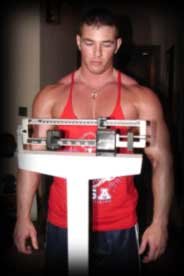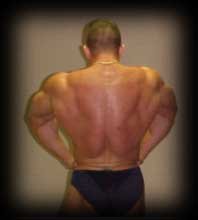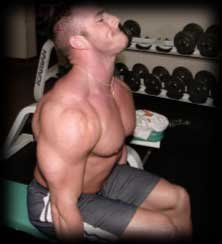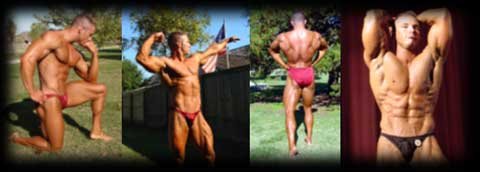Diet
For me, the most important issue to address is the diet. Depending on where you are starting from (how far from contest weight), you will need to begin altering your diet to your specific needs. For example a bodybuilder who needs to lose 10 pounds to achieve contest weight can take their diet rather slowly and alter as they go. However, one who needs to lose 50 pounds has got to get on the train.
The first thing one needs to look at is protein intake. Most people will recommend between 1.0 and 1.5 grams of protein per pound of body weight per day. For example: a 150 lb. Bodybuilder would need to take in between 150 and 225 grams per day.
Below is an example of weeks 1 to 4 of my pre-contest diet.
| Meal 1: | Meal 2: |
| 12 egg whites | 2 eye round steaks (6 oz. Each) |
| 1 serving grits | broccoli |
| 1 banana | baked potato |
| Meal 3: Pre-Workout | Meal 4: Post-Workout |
| Protein shake w/ Glutamine | Protein shake w/ Glutamine |
| carb drink (100g) | |
| Meal 5: | Meal 6: |
| 2 chicken breasts (6 oz. Each) | 2 eye round steaks (6 oz. Each) |
| asparagus (4 oz.) | broccoli (4-6 oz) |
| steamed rice (1/2 cup) | steamed rice (1/2 cup) |
| Meal 7: | |
| 1 can tuna (low sodium) | |
| 1 whole wheat bagel | |
All these meals are eaten two (2) hours apart. To manipulate this diet for closer to contest, lower sodium intake to approximately 2 grams per day. Also, substitute sweet potatoes for baked potatoes as the glycemic index is much different. The steamed rice should only include brown rice. I liked to use a wild rice/brown rice blend for flavor.
One thing you must also keep in mind is water intake. Eight (8) glasses a day is insufficient for a bodybuilder especially during contest preparation. Try to drink between 1.5 and 2 gallons of water a day. I liked to use a sugar-free peach flavored tea mix with my water to help in getting rid of unwanted water at around 6 weeks out. Water will help to keep your kidneys functioning properly despite the additional load caused by increased protein consumption.
Cardiovascular Exercise
 Depending on your general conditioning, cardiovascular exercise (cardio) weighs differently in each person's preparation. The two things to keep in mind when doing cardio are intensity and duration.
Depending on your general conditioning, cardiovascular exercise (cardio) weighs differently in each person's preparation. The two things to keep in mind when doing cardio are intensity and duration.
Intensity is your perception as to how much effort you are putting forth. Typically, for weight/fat loss, one would try to keep in the range of 70-80% maximum heart rate for best results. To figure 70% maximum heart rate 1) 220 minus your age 2) multiply by .70. This will give you 70% of maximum heart rate.
Duration is the amount of time actually spent performing the exercise. To manipulate intensity and duration, you can 1) increase intensity, decrease duration or 2) decrease intensity, increase duration. Thus, either work harder or work longer.
My experience tells me that a lower intensity, higher duration cardio routine works better for cardiovascular conditioning. But if you are targeting bodyweight reduction for a contest, try a higher intensity, shorter duration program.
The means by which to perform this segment of contest preparation depends upon the person. Research shows that swimming is the best cardio type program but can be difficult to find a good indoor pool during the winter months. Treadmills, stationary bicycles, or elliptical runners are more convenient for most people. Stationary bicycles and elliptical runners are best for people with knee, hip, or ankle problems due to limited compression on the joints. From personal experience I found that wearing headphones and/or watching television help to pass the minutes much quicker.
Time of day is a crucial but controversial aspect of cardio training. Most bodybuilders find that doing cardio in the morning is better due to your body being in caloric debt secondary to sleep. The majority of us do not eat while we are asleep. Therefore, if you train before you eat your body is going to metabolize stored caloric deposits more readily.
Training Ideas
Pre-contest weight training is a key ingredient for maintaining muscle size, separation, and clarity. You can stick with your previous program if you manipulate your training strategy.
 One idea to try is drop sets. Perform as many repetitions as you can with a weight, decrease weight 25%, perform maximum number of reps, decrease weight 25%, perform maximum number of reps, rest. This will give your muscles an incredible pump and will also help to bring out the separation between muscles. Depending on your body, you can either follow your off-season program or switch to a higher repetition/lower weight strategy. Higher repetition/lower weight will help to recruit the slow-twitch (Type I) fibers. Most bodybuilders try to focus on the fast-twitch (Type IIB) fibers due to their larger size.
One idea to try is drop sets. Perform as many repetitions as you can with a weight, decrease weight 25%, perform maximum number of reps, decrease weight 25%, perform maximum number of reps, rest. This will give your muscles an incredible pump and will also help to bring out the separation between muscles. Depending on your body, you can either follow your off-season program or switch to a higher repetition/lower weight strategy. Higher repetition/lower weight will help to recruit the slow-twitch (Type I) fibers. Most bodybuilders try to focus on the fast-twitch (Type IIB) fibers due to their larger size.
It is always a good idea to keep safety in mind when training. This is especially true during contest preparation as your body is more prone to injury when energy is depleted. Thus, try to go more towards the machine or cable exercises as these are more controlled and less likely to cause injury if you lose form. I am not, however, saying you should ignore the free weights. These are the meat and potatoes of most workouts and help to recruit secondary muscle groups (stabilizers) which will help add to size.
My final training tip is to keep your program changing. Do not let it become a routine as your body, and mind, will become bored. The human body adapts to stress very well and once it adapts it does not respond with the desired muscle hypertrophy. This is when you will hit a plateau. When this happens you have several options 1) change days you work each muscle group 2) alternate in different exercises each time you work a muscle 3) manipulate weight and repetitions and 4) increase or decrease rest between sets. These are just a few ideas I have found that work for me.
Body Preparation
 We are finally at the point to prepare your body for display. Tanning should begin at least six (6) weeks before the show. Tanning not only gives your body a nice, appealing look but helps to get rid of that tough to lose water on the abs, lower back, and glutes. Try to get as dark as you can so you don't have to apply so much Pro-Tan. If you are white and put on Pro-Tan it makes your skin look orange. Also, when tanning use items like Ripping Gel, Cutting Gel, or anything containing niacin. This will help to bring the water out from the subcutaneous tissue. A cheaper route would be to use Preparation-H. Just apply to the areas you are holding water right before you get into the tanning bed.
We are finally at the point to prepare your body for display. Tanning should begin at least six (6) weeks before the show. Tanning not only gives your body a nice, appealing look but helps to get rid of that tough to lose water on the abs, lower back, and glutes. Try to get as dark as you can so you don't have to apply so much Pro-Tan. If you are white and put on Pro-Tan it makes your skin look orange. Also, when tanning use items like Ripping Gel, Cutting Gel, or anything containing niacin. This will help to bring the water out from the subcutaneous tissue. A cheaper route would be to use Preparation-H. Just apply to the areas you are holding water right before you get into the tanning bed.
The application of Pro-Tan, or "paint", should be done by someone with experience to give a consistent appearance to your skin color. You do not want blotches, streaks, or light areas. This gives your body an unbalanced appearance in the bright stage lights and will cost you on the judges' score cards. Make sure you are dark enough to bring out definition, muscle separation, and striations. You can either start this application 2-3 days before the show or do the morning of the show but I had good results with starting 3 days before.
The final body preparatory phase is application of Hot-Stuff. This is a vasodilator which really brings out your vascularity and eliminates the need for posing oil or vegetable oil sprays. It smells awful but really cleans out your sinuses! Typically, there will be an expeditor to help with this so you don't have to get it all over your hands.
I hope this narrative of my 12 week process is helpful. Give it a try for your next show. It worked well for me.
Thank you for reading this article!
Jon Huston
